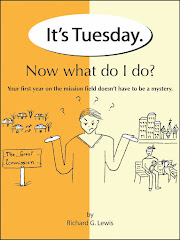 Last Sunday I taught the first of a four-part series on cross-cultural missions at the Temple Baptist Church in Springdale, Arkansas. I am particularly pleased with this opportunity as, for once, I will be able to speak and explain missions in a broader framework than what is the norm. Most of the time when I am asked to speak in churches it’s usually just for a Sunday morning, a half-hour talk, perhaps one hour if I am speaking to the early morning Bible class. In that limited space of time there is not much one can do in terms of information and the best I can do is to introduce who I am, where I work and a cursory description of what I do. Most of the time people expect inspiration from the missionary speaker, not education. However, with a fifty-minute class for four consecutive Sundays at least people will have a better understanding of the dynamics of cross-cultural communication and how cultural anthropology can be a tool for ministry.
Last Sunday I taught the first of a four-part series on cross-cultural missions at the Temple Baptist Church in Springdale, Arkansas. I am particularly pleased with this opportunity as, for once, I will be able to speak and explain missions in a broader framework than what is the norm. Most of the time when I am asked to speak in churches it’s usually just for a Sunday morning, a half-hour talk, perhaps one hour if I am speaking to the early morning Bible class. In that limited space of time there is not much one can do in terms of information and the best I can do is to introduce who I am, where I work and a cursory description of what I do. Most of the time people expect inspiration from the missionary speaker, not education. However, with a fifty-minute class for four consecutive Sundays at least people will have a better understanding of the dynamics of cross-cultural communication and how cultural anthropology can be a tool for ministry.The key to my teaching, and indeed all-good teaching, is relevance for the audience. Springdale is a city of less than 70,000 people. Thirty years ago it was a farming community made up of White Anglo Saxons. Today the Hispanic population is over 20% (locals are convinced they are much more), a large immigrant population from the Marshall Islands as well as people from India, Thailand and other parts of the world. For some locals they see the change in their little town as a threat to their way of life. Understandable. For many more, they accept the reality of change but wonder what they, individually as well as a corporate body of believers, should do about this shift toward ethnic diversity. My illustrations on working with the tribal people of Kenya or pastors in Ukraine aren’t worth the effort for them to sit and listen to a missionary four straight Sundays. However, if I can help them connect the dots on how they can develop friendships with “foreigners” (a term I loathe but referred to when every time I leave the U.S.) and how they can be a bridge in communicating the Gospel through these friendships, it will be time well spent. If I can help some just get over the animosity they feel for those who are now a part of their community I will feel I’ve made a huge contribution in my service to the church.
My only regret is that this format of information is not used more in local churches - not just for the American church, but for every congregation throughout God’s created globe.

